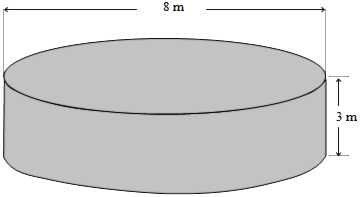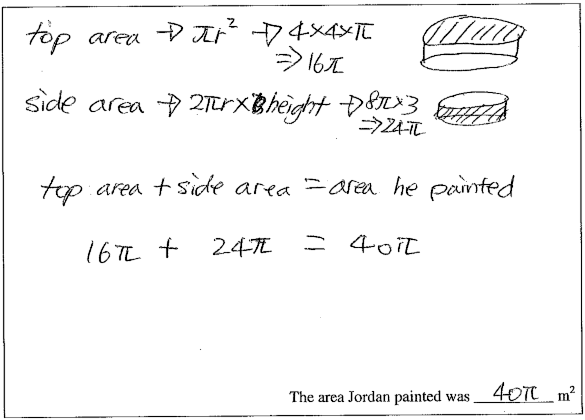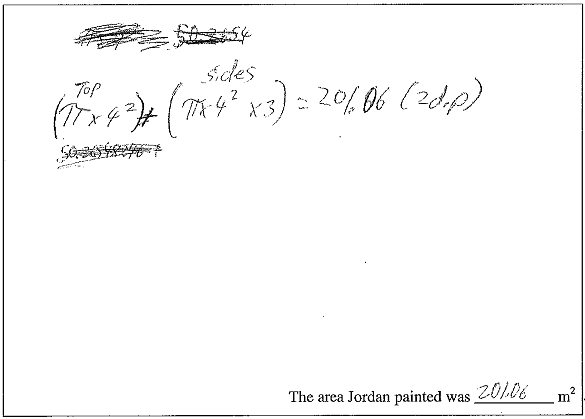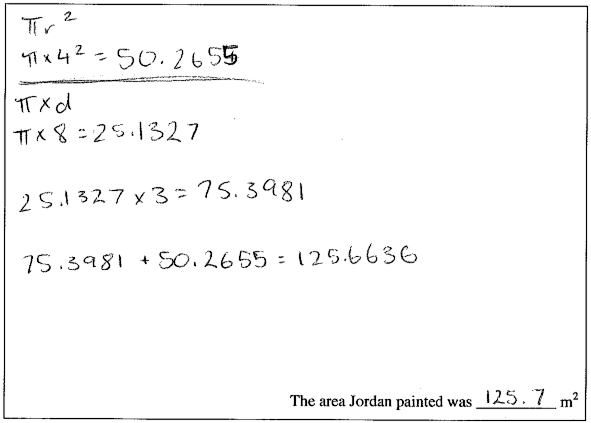Painting a water tank
|

Jordan painted this water tank with one coat of paint.
- First he painted the top.
- Then he painted the sides.
Show how to work out the area he painted (show all of your working, including any diagrams).
|
The area Jordan painted was __________ m2 |
| Y10 (11/2009) | |
|
Working
Annotation of working
|
easy moderate
very difficult difficult |
NOTE: Accept each stage of the working if the method used for it is correct (e.g., πr 2) even if some numerical calculation errors are made
| Common response | Likely misconception |
|
Area of top =πd =25.1 [This leads to answers close to 75.4] |
Confuses the area of a circle and the circumference of circle |
|
Area of top =πd 2 (201.1) |
Confuses radius and diameter |
|
Area of top = (πr)2, (πd)2, πd.2, πr.2 |
Misapplies formulae (including either of above misconceptions) |
|
Area of side = area of top × 3 |
Confuses area and volume or cannot visualise the 3-D shape |
| Area of top = 8 |
Cannot visualise the 3-D shape |
|
Area of top + Area of side + Area of bottom |
Adds incorrect components to obtain the surface area - cannot visualise the 3-D shape |
Student strategies
Students who misapply formulae need to know:
- the meaning of "squared", so r2 = r × r (and it is not r × 2); and
- the BEDMAS rule for order of operations. This means that the r should be squared before multiplying by π. For resources on this use the keyword or click on the link; order of operations.
Confuses the area of a circle and the circumference of circle
Students need to be clear that:
- circumference is a measure of length, which means that it should be measures in metres (m). Only one length measure (diameter or 2 × radius) should be used in its calculation; and
- area is a square measure such as square metres (m2). It should therefore include multiplying two lengths together. Students may know that a rectangle has an area = width × height, each of which is measured in metres, so the result is measured in square metres (m2). This is the effect of the r2, because r is measured in metres.
Students could explore circumferences (click on the keyword or use the link; circumference); or
Explore area of circles (click on the keyword or use the link; circles AND area).
Confuses radius and diameter
This is a basic geometric knowledge issue. One easy way to see that πd 2 is incorrect is to draw a square around the circle. The area of the square is d 2 so the circle must be less than this, i.e. πr 2.

Confuses area and volume
Students need to be clear that:
- area is a square measure such as square metres (m2). It should therefore include multiplying two lengths together.
- volume is a cubic measure such as cubic metres (m3). It should therefore include multiplying three lengths together.
Cannot visualise the 3-D shape
- Students need to be able to visualise that the side of the tank is in fact a long, thin rectangle. It has a length equal to the distance around the circle (the circumference), and a height of 3 metres
- Students could make a 3-D model by cutting out a circle of diameter 8 cm (radius 4 cm and use a compass). They could then cut out a long rectangle that is 3cm wide, and wrap this around the outside of the circle. This leads to the equation circumference × 3 for the area of the strip.
Examples of student working
The following show successful or nearly successful strategies for solving the problem with the working displayed. They show different levels of annotation of what each of the formulae represent (e.g. "side of tank", "length around the top of the tank" etc.). Some employ the use of diagrams as well. The most effective diagrams had the relevant dimension displayed on them.

High level of annotation including the use of 2-D and 3-D diagrams with relevant dimensions displayed.

Low level of annotation but good use of 2-D diagrams with relevant dimensions displayed.

High level of annotation including the use of 2-D diagrams without the relevant dimensions displayed.

High level of annotation including the use of 2-D diagrams without the relevant dimensions displayed. Sophisticated use of π.

Low level of annotation. Includes an error in the calculation of the side length. Full credit for working was given, but the student got no credit for their answer.

Clearly shows calculations used and a correct answer, but with no annotation.

